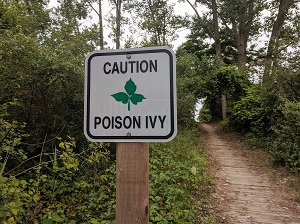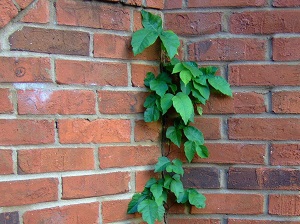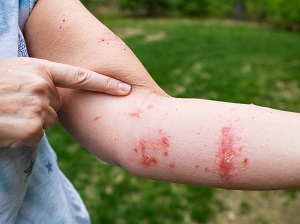Poison Ivy grows as a small shrub or a vine that can trail along the ground or climb through other plants or onto trees and poles. In a landscape setting, a poison ivy plant can look quite lovely, especially as a vine, but that’s why it’s important to be able to recognize this dangerous plant so it can be avoided.
Don't forget the old saying, Leaves of Three, Let It Be. This is a great way to remember what to look out for when you are gardening or hiking.

Poison Ivy can be found throughout the United States in nearly every state except Alaska, Hawaii and parts of California. Poison Ivy is a perennial, and the leaves are not always green. In the spring and fall poison ivy leaves can be red, orange, or yellow, but they are no less toxic.
Poison Ivy Exposure
When the sticky sap oil from poison ivy, called urushiol, comes in contact with the skin, it can cause an allergic reaction. Unfortunately, poison ivy can spread urushiol to the skin in all seasons. Even in winter, when the leaves are gone, the sticky oil can still be spread by the plant’s berries or aerial roots.
There are different ways a person can be exposed to the sap oil from poison ivy, including:
- Direct contact with a poison ivy plant.
- Touching something else that came in contact with the poison ivy plant like tools, animals, or clothing that have the urushiol on them.
- Inhaling particles from burning plants that contain urushiol.

Poison Ivy Symptoms After Contact
About 85% of Americans are allergic to poison ivy. Symptoms may include:
- Red Rash
- Swelling
- Itching
- Blisters (note: blister fluids are not contagious)
- Difficulty breathing (if inhaled)
The rash may begin appearing within 12 hours after contact, or it may take a few days to fully develop. About 10-15% of people who are allergic to poison ivy will develop a severe reaction with symptoms that may include severe swelling, difficulty breathing or blisters that become inflamed and infected.

How to Avoid Poison Ivy
The best way to avoid poison ivy is to become familiar with what the plant looks like and stay away from it.
- If you find poison ivy growing as a vine in your yard, cut the vine off at the ground but don’t touch it, just leave it hanging. It will dry, gradually release its hold, and the pieces will fall to the ground.
- If you think you may be working or hiking near poison ivy, wear long sleeves, long pants tucked into boots, and gloves. Wear eye protection while mowing.
- If you can’t cover your body completely, an ivy blocking cream that contains bentoquatam may help protect your skin.
- Wash your garden tools and gloves regularly.
- Do not burn plants or brush piles that may contain poison ivy.

What To Do After Poison Ivy Exposure
For anyone that has been exposed to poison ivy, swift action should be taken. The sooner you cleanse the skin, the greater the chance that you can remove the plant oil to prevent further spread.
- Immediately wash skin with rubbing alcohol, poison plant wash, or a dishwashing soap. Rinse with a lot of water so that the wash solutions do not dry on the skin.
- Scrub under nails with a brush.
- Wash exposed clothing separately in hot water with detergent.
- As the rash begins to develop, apply wet compresses, calamine lotion, or hydrocortisone cream to the skin to reduce itching and blistering. Oatmeal baths and antihistamines may also help to relieve itching.
- In severe cases, if you have difficulty breathing or swallowing, you have a fever, or if the rash is on the face, mouth, or genitals, seek professional medical attention.

If your pet may have come in contact with poison ivy, wash them with pet shampoo while wearing rubber gloves. Your pet may not be sensitive to the poison ivy, but the oil can stick to their fur and cause a reaction in someone who pets them later.
Carefully clean any items that may have touched poison ivy. Gardening tools, sporting equipment, and camping supplies can all get the sticky oil on them.
Do your best not to scratch the rash and the blisters. Scratching the rash may bring immediate comfort but can prolong the symptoms. If the scratching is intense, it can break the skin and result in infection.
There is no cure for a poison ivy rash. The rash and blisters will normally clear up within a few weeks without any treatment.

.jpeg)

.jpg)